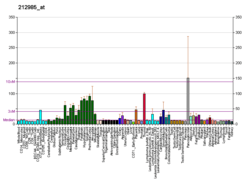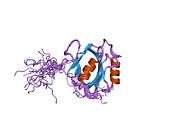APBB2
Amyloid beta A4 precursor protein-binding family B member 2 is a protein that in humans is encoded by the APBB2 gene.[5][6][7]
The protein encoded by this gene interacts with the cytoplasmic domains of amyloid beta (A4) precursor protein and amyloid beta (A4) precursor-like protein 2. This protein contains two phosphotyrosine binding (PTB) domains, which are thought to function in signal transduction.[7]
References
- 1 2 3 GRCh38: Ensembl release 89: ENSG00000163697 - Ensembl, May 2017
- 1 2 3 GRCm38: Ensembl release 89: ENSMUSG00000029207 - Ensembl, May 2017
- ↑ "Human PubMed Reference:".
- ↑ "Mouse PubMed Reference:".
- ↑ McLoughlin DM, Miller CC (Jan 1997). "The intracellular cytoplasmic domain of the Alzheimer's disease amyloid precursor protein interacts with phosphotyrosine-binding domain proteins in the yeast two-hybrid system". FEBS Lett. 397 (2–3): 197–200. doi:10.1016/S0014-5793(96)01128-3. PMID 8955346.
- ↑ Blanco G, Irving NG, Brown SD, Miller CC, McLoughlin DM (Jun 1998). "Mapping of the human and murine X11-like genes (APBA2 and apba2), the murine Fe65 gene (Apbb1), and the human Fe65-like gene (APBB2): genes encoding phosphotyrosine-binding domain proteins that interact with the Alzheimer's disease amyloid precursor protein". Mamm Genome. 9 (6): 473–5. doi:10.1007/s003359900800. PMID 9585438.
- 1 2 "Entrez Gene: APBB2 amyloid beta (A4) precursor protein-binding, family B, member 2 (Fe65-like)".
External links
- Human APBB2 genome location and APBB2 gene details page in the UCSC Genome Browser.
Further reading
- Guénette SY, Chen J, Jondro PD, Tanzi RE (1996). "Association of a novel human FE65-like protein with the cytoplasmic domain of the beta-amyloid precursor protein". Proc. Natl. Acad. Sci. U.S.A. 93 (20): 10832–7. doi:10.1073/pnas.93.20.10832. PMC 38241. PMID 8855266.
- Bruni P, Minopoli G, Brancaccio T, et al. (2002). "Fe65, a ligand of the Alzheimer's beta-amyloid precursor protein, blocks cell cycle progression by down-regulating thymidylate synthase expression". J. Biol. Chem. 277 (38): 35481–8. doi:10.1074/jbc.M205227200. PMID 12089154.
- Strausberg RL, Feingold EA, Grouse LH, et al. (2003). "Generation and initial analysis of more than 15,000 full-length human and mouse cDNA sequences". Proc. Natl. Acad. Sci. U.S.A. 99 (26): 16899–903. doi:10.1073/pnas.242603899. PMC 139241. PMID 12477932.
- Chang Y, Tesco G, Jeong WJ, et al. (2004). "Generation of the beta-amyloid peptide and the amyloid precursor protein C-terminal fragment gamma are potentiated by FE65L1". J. Biol. Chem. 278 (51): 51100–7. doi:10.1074/jbc.M309561200. PMID 14527950.
- Gerhard DS, Wagner L, Feingold EA, et al. (2004). "The Status, Quality, and Expansion of the NIH Full-Length cDNA Project: The Mammalian Gene Collection (MGC)". Genome Res. 14 (10B): 2121–7. doi:10.1101/gr.2596504. PMC 528928. PMID 15489334.
- Li Y, Hollingworth P, Moore P, et al. (2006). "Genetic association of the APP binding protein 2 gene (APBB2) with late onset Alzheimer disease". Hum. Mutat. 25 (3): 270–7. doi:10.1002/humu.20138. PMID 15714520.
- Lange A, Thon L, Mathieu S, Adam D (2005). "The apoptosis inhibitory domain of FE65-like protein 1 regulates both apoptotic and caspase-independent programmed cell death mediated by tumor necrosis factor". Biochem. Biophys. Res. Commun. 335 (2): 575–83. doi:10.1016/j.bbrc.2005.07.125. PMID 16083851.
- Rual JF, Venkatesan K, Hao T, et al. (2005). "Towards a proteome-scale map of the human protein-protein interaction network". Nature. 437 (7062): 1173–8. doi:10.1038/nature04209. PMID 16189514.
- Hong Q, Hsu LJ, Schultz L, et al. (2007). "Zfra affects TNF-mediated cell death by interacting with death domain protein TRADD and negatively regulates the activation of NF-κB, JNK1, p53 and WOX1 during stress response". BMC Mol. Biol. 8: 50. doi:10.1186/1471-2199-8-50. PMC 1904229. PMID 17567906.
This article is issued from
Wikipedia.
The text is licensed under Creative Commons - Attribution - Sharealike.
Additional terms may apply for the media files.








